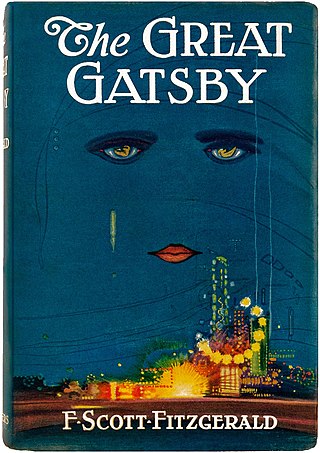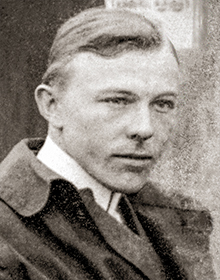
The Great Gatsby is a 1925 novel by American writer F. Scott Fitzgerald. Set in the Jazz Age on Long Island, near New York City, the novel depicts first-person narrator Nick Carraway's interactions with mysterious millionaire Jay Gatsby and Gatsby's obsession to reunite with his former lover, Daisy Buchanan.

Zelda Fitzgerald was an American novelist, painter, playwright, and socialite. Born in Montgomery, Alabama, to a wealthy Southern family, she became locally famous for her beauty and high spirits. In 1920, she married writer F. Scott Fitzgerald after the popular success of his debut novel, This Side of Paradise. The novel catapulted the young couple into the public eye, and she became known in the national press as the first American flapper. Due to their wild antics and incessant partying, she and her husband became regarded in the newspapers as the enfants terribles of the Jazz Age. Alleged infidelity and bitter recriminations soon undermined their marriage. After traveling abroad to Europe, Zelda's mental health deteriorated, and she had suicidal and homicidal tendencies which required psychiatric care. Her doctors diagnosed Zelda with schizophrenia, although later posthumous diagnoses posit bipolar disorder.

Frances Scott "Scottie" Fitzgerald was an American writer and journalist and the only child of novelist F. Scott Fitzgerald and Zelda Sayre Fitzgerald. She matriculated from Vassar College and worked for The Washington Post, The New Yorker, and other publications. She became a prominent member of the Democratic Party.

Save Me the Waltz is a 1932 novel by American writer Zelda Sayre Fitzgerald. It is a semi-autobiographical account of her early life in the American South during the Jim Crow era and her tempestuous marriage to novelist F. Scott Fitzgerald. She composed the work while a patient at Johns Hopkins Hospital's Phipps Clinic in Baltimore, Maryland. As part of her recovery routine, she spent at least two hours a day writing a novel. She sent the manuscript to her husband's editor, Maxwell Perkins. Although unimpressed by the manuscript, Perkins published the work in order for Fitzgerald to repay his financial debt to his publisher Scribner's.

This Side of Paradise is the debut novel by American writer F. Scott Fitzgerald, published in 1920. It examines the lives and morality of carefree American youth at the dawn of the Jazz Age. Its protagonist, Amory Blaine, is an attractive middle-class student at Princeton University who dabbles in literature and engages in a series of romances with flappers. The novel explores the theme of love warped by greed and status-seeking, and takes its title from a line of Rupert Brooke's poem Tiare Tahiti.

Tender Is the Night is the fourth and final novel completed by American writer F. Scott Fitzgerald. Set in French Riviera during the twilight of the Jazz Age, the 1934 novel chronicles the rise and fall of Dick Diver, a promising young psychiatrist, and his wife, Nicole, who is one of his patients. The story mirrors events in the lives of the author and his wife Zelda Fitzgerald as Dick starts his descent into alcoholism and Nicole descends into mental illness.

The Beautiful and Damned is a 1922 novel by American writer F. Scott Fitzgerald. Set in New York City, the novel's plot follows a young artist Anthony Patch and his flapper wife Gloria Gilbert who become "wrecked on the shoals of dissipation" while excessively partying at the dawn of the hedonistic Jazz Age. As Fitzgerald's second novel, the work focuses upon the swinish behavior and glittering excesses of the American social elite in the heyday of New York's café society.

"Head and Shoulders" is a short story by F. Scott Fitzgerald. It was his first story to be published in the Saturday Evening Post, with the help of Fitzgerald's agent, Harold Ober. The story appeared in the February 21, 1920 issue and was illustrated by Charles D. Mitchell. It later appeared in his short story collection Flappers and Philosophers.

Jay Gatsby is the titular fictional character of F. Scott Fitzgerald's 1925 novel The Great Gatsby. The character is an enigmatic nouveau riche millionaire who lives in a luxurious mansion on Long Island where he often hosts extravagant parties and who allegedly gained his fortune by illicit bootlegging during prohibition in the United States. Fitzgerald based many details about the fictional character on Max Gerlach, a mysterious neighbor and World War I veteran whom the author met while living in New York City during the raucous Jazz Age. Like Gatsby, Gerlach threw lavish parties, never wore the same shirt twice, used the phrase "old sport", claimed to be educated at Oxford University, and fostered myths about himself, including that he was a relation of the German Kaiser.

"Winter Dreams" is a short story by F. Scott Fitzgerald that was first published in Metropolitan magazine in December 1922 and later collected in All the Sad Young Men in 1926. The plot concerns the attempts by a young man to win the affections of an upper-class woman. The story, frequently anthologized, is regarded as one of Fitzgerald's finest works "for poignantly portraying the loss of youthful illusions."

The Great Gatsby is a 2000 British-American romantic drama television film, based on the 1925 novel of the same name by F. Scott Fitzgerald. It was directed by Robert Markowitz, written by John J. McLaughlin, and stars Toby Stephens in the title role of Jay Gatsby, Mira Sorvino as Daisy Buchanan, Paul Rudd as Nick Carraway, Martin Donovan as Tom Buchanan, Francie Swift as Jordan Baker, Heather Goldenhersh as Myrtle Wilson, and Matt Malloy as Klipspringer. The film aired on March 29, 2000 in the United Kingdom on BBC, and on January 14, 2001 in the United States on A&E.

Daisy Fay Buchanan is a fictional character in F. Scott Fitzgerald's 1925 novel The Great Gatsby. The character is a wealthy socialite from Louisville, Kentucky who resides in the fashionable town of East Egg on Long Island during the Jazz Age. She is narrator Nick Carraway's second cousin, once removed, and the wife of polo player Tom Buchanan, with whom she has a daughter. Before marrying Tom, Daisy had a romantic relationship with Jay Gatsby. Her choice between Gatsby and Tom is one of the novel's central conflicts. Described by Fitzgerald as a "golden girl", she is the target of both Tom's callous domination and Gatsby's dehumanizing adoration. The ensuing contest of wills between Tom and Gatsby reduces Daisy to a trophy wife whose sole existence is to augment her possessor's socioeconomic success.

Nick Carraway is a fictional character and narrator in F. Scott Fitzgerald's 1925 novel The Great Gatsby. The character is a Yale University alumnus from the American Midwest, a World War I veteran, and a newly arrived resident of West Egg on Long Island, near New York City. He is a bond salesman and the neighbor of enigmatic millionaire Jay Gatsby. He facilitates a sexual affair between Gatsby and his second cousin, once removed, Daisy Buchanan which becomes one of the novel's central conflicts. Carraway is easy-going and optimistic, although this latter quality fades as the novel progresses. After witnessing the callous indifference and hedonism of the idle rich during the riotous Jazz Age, he ultimately chooses to leave the eastern United States forever and returns to the Midwest.

Francis Scott Key Fitzgerald was an American novelist, essayist, and short story writer. He is best known for his novels depicting the flamboyance and excess of the Jazz Age—a term he popularized in his short story collection Tales of the Jazz Age. During his lifetime, he published four novels, four story collections, and 164 short stories. Although he achieved temporary popular success and fortune in the 1920s, Fitzgerald received critical acclaim only after his death and is now widely regarded as one of the greatest American writers of the 20th century.

Ginevra King Pirie was an American socialite and heiress. As one of Chicago's "Big Four" debutantes during World War I, she inspired many characters in the novels and stories of writer F. Scott Fitzgerald; in particular, the character of Daisy Buchanan in The Great Gatsby. A 16-year-old King met an 18-year-old Fitzgerald at a sledding party in Saint Paul, Minnesota, and they shared a passionate romance from 1915 to 1917.

All the Sad Young Men is the third collection of short stories written by F. Scott Fitzgerald, published by Scribners in February 1926.

"The Offshore Pirate" is a short story written by F. Scott Fitzgerald in 1920. It is one of eight short stories included in Fitzgerald's first published collection, Flappers and Philosophers. The story was first published in the May 29, 1920 issue of The Saturday Evening Post and illustrated by Leslie L. Benson. The story was Fitzgerald's third appearance in the magazine that month. It demonstrates his rapid development as a versatile fiction writer. It is the first story that develops Fitzgerald's recurrent plot idea of a heroine won by her lover's performance of an extraordinary deed.
"Absolution" is a short story by American writer F. Scott Fitzgerald. It was included in his 1926 collection All the Sad Young Men.

Max von Gerlach was an acquaintance of American writer F. Scott Fitzgerald in New York. Gerlach was an officer in the American Expeditionary Forces during World War I who became a gentleman bootlegger and lived like a millionaire in New York. Flaunting his wealth as a bootlegger, Gerlach threw lavish parties, never wore the same shirt twice, used the phrase "old sport", claimed to be educated at Oxford University, and fostered myths about himself; including that he was a relation of the German Kaiser. These details about Gerlach inspired Fitzgerald in his creation of Jay Gatsby, the titular character of The Great Gatsby.
"Echoes of the Jazz Age" is a short essay by American writer F. Scott Fitzgerald that was first published in Scribner's Magazine in November 1931. The essay analyzes the societal conditions in the United States which gave rise to the raucous historical era known as the Jazz Age and the subsequent events which led to the era's abrupt conclusion. The frequently anthologized essay represents an extended critique by Fitzgerald of 1920s hedonism and is regarded as one of Fitzgerald's finest non-fiction works.



















